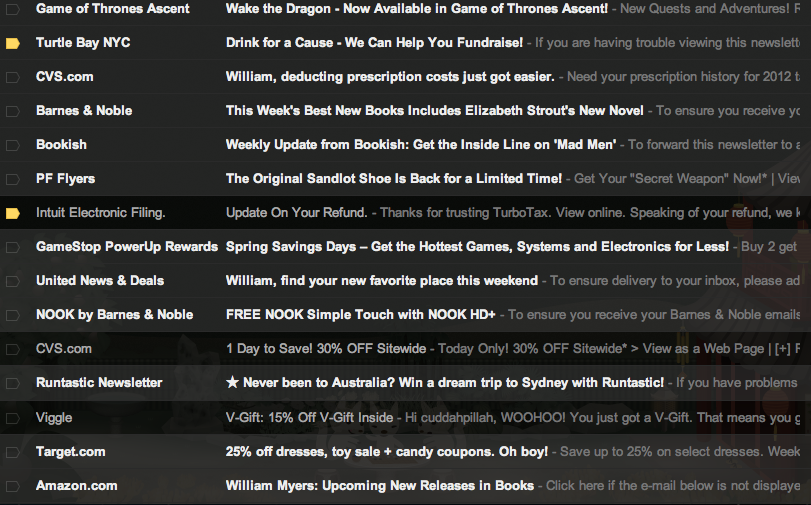Last week was all about the cold, hard facts behind email personalization. Metrics, percentages and info-graphics all agree: personalized emails work and people like them.
But this week is all about the WHY. Why do people value personalized emails? Why are open rates 30% higher for personalized emails? Why does even the lightest touch of personalization (a local restaurant name-dropped in the subject line, a pet-specific offer for your cat-owning subscribers) make you want to click through or buy or sign up or, at the very least, not mark as spam?
What is it about email personalization that makes customers hearts swoon?
The answer lies in the recent evolution of customer-centricity. These days, brand loyalty can only take you so far. More and more customers are beginning to say, “It’s not about you, it’s about me.”
Just take a look at my own inbox.

As you can see, I get a quite a few different email offers and newsletters every day. So do most people. Maybe we don’t all get emails from a Game of Thrones-themed Facebook game but that’s an issue for a different blog.
Back to the inbox. Clearly, I did not open most of these emails (the bright white ones are unopened). Why not? Well, for the most part, they just don’t speak to me. Almost all are generic, unpersonalized, offering things I’m not really interested in. In short, they’re not about me, the customer.
Let’s take a closer look. First, the few I did open:
1. Intuit Electronic Filing – Update On Your Refund: Short, concise, customer-centric. This email may not seem personalized but it’s actually in direct response to my activity on the TurboTax site. I filed my taxes on their website a few weeks ago and now they’re following up. And, of course, I want to see what’s up with my refund. Free money.
2. CVS.com – 1 Day to Save! 30% OFF Sitewide: I get CVS emails all the time because I have an ExtraCare card. They know I use their coupons often so I usually click to see their new offers. Why didn’t I click on the other CVS email? I only open those with explicit deals. Call me thrifty.
3. Viggle – V-Gift: 15% Off V-Gift Inside: This email is in response to a TV show I checked in to with Viggle. You check in, you get a reward. I want to see my reward.
What’s the common thread between the three emails I did open? They were all about me. TurboTax used their customer data to follow up on my tax returns. CVS used their loyalty card data to offer me a discount. Viggle piggybacked my action on their app with an email offer.
What’s the common thread between the emails I skipped over? No personalization. Generic offers. No customer-centricity. At most, some included my name (though not the nickname I actually go by). However, name personalization is not great. Studies show that names in the subject line can lower open rates just as often as raise them. The real issue with these unopened emails is that not one tried to appeal to me.
Take Target. I’m a single male in his 20s. But I don’t want to buy dresses or toys even if they’re 25% off. Take Turtle Bay NYC. I’m their key demographic…but I live in Chicago and I’m just not willing to make that commute for happy hour. The real way to a customer’s heart (and click) is through personalization. If you don’t want your emails to fade away, unopened and unloved, you’ve got to figure out who you’re emailing and then make it about them.
Here at Rapleaf, we like to think you can use data to personalize any part of your emails from the beginning of the subject line to the graphic at the bottom. For three easy ways you can personalize with Rapleaf, check out this personalization guide we put together.
Alright, I’m off to watch Game of Thrones.
 Affiliate Marketing
Affiliate Marketing Automotive
Automotive eCommerce and Retail
eCommerce and Retail FinTech
FinTech LeadGen
LeadGen Nonprofit and Political
Nonprofit and Political Payments
Payments Technology Platforms
Technology Platforms Tourism and Hospitality
Tourism and Hospitality

